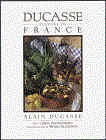
|
| |
| Ducasse Flavors of France Brash, driven, and dazzlingly inventive, six-star-chef Alain Ducasse is a larger-than-life figure. At thirty-three, he was the youngest chef ever to be awarded three Michelin stars, and in March 1998, he became the only chef in our time to possess six stars. He has mentored a generation of younger chefs who have introduced his cooking around the world and has, quite simply, changed the face of traditional French cooking. |
 |
Ducasse Flavors of France by Alain Ducasse, Linda Dannenberg (Contributor), Pierre Hussenot (Photographer) List Price: $60.00 Our Price: $42.00 Hardcover - 288 pages 1 Ed edition (November 1998) Artisan ISBN: 1579651070 Dimensions (in inches): 1.03 x 12.38 x 9.38 Order this Book |
| In his long-awaited American cookbook debut, M. Ducasse whares the principles and
techniques of his uniquely elemental cuisine. At its core are clarity of taste, precision
in execution, and respect for the food itself, which to Ducasse means retaining in a
multitude of simple but striking techniques, such as combinng in the same recipe raw and
cooked, hot and cold, fruits and vegetables. Ducasse uses as much of each element as he
can--the trimmings, sometimes the skins, the shells, the baking juices, the pan drippings,
the heads, the cooking broth, all the by-products of the process--in order to capture an
ingredient's precise taste. He incorporates different preparations of the sam product into
a given dish, each revealing an individual aspect of its flavor--sliced raw artichokes,
braised whole artichokes, and paper-thin slices of fried artichoke, for example, might be
featured together. The brilliance of his food--apparent in receipes made with no more than
two ingredients enhanced by a simple aromatic element, with seasoning reduced to a few
grains of salt--explains why he is "the country's star chef" (Wine Spectator)
and "the Escoffier of our time" (Le Point). Ducasse Flavors of France documents, in more than one hundred lavishly photographed recipes, the influences--Mediterranean, Provencal, and classical French--that permeate this extraordinary cuisine. Many of the recipes are simple, others complex, but all can be perfectly accomplished with a little time and patience. Table of Contents About the Author |
|
|
International Book Shop: Canada - Germany - United Kingdom This Book Store is brought to you by
PastryWiz in association with
Amazon.com |
|
Recipes: |